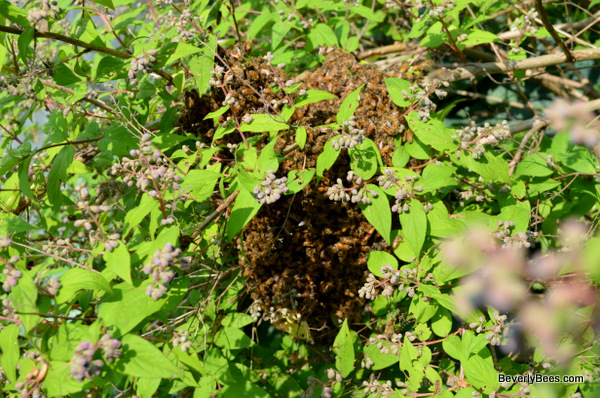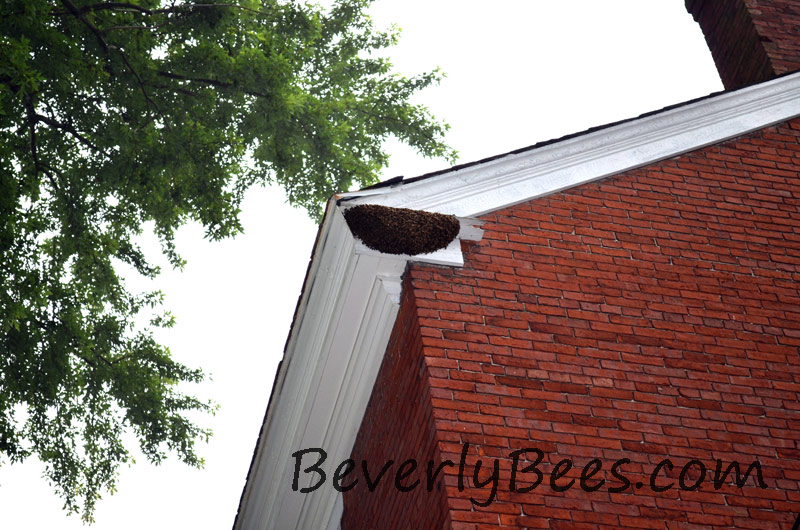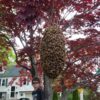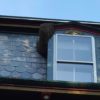by Anita Deeley at BeverlyBees.com
Have a bee swarm? We offer bee removal service for bee swarms in Essex County, Middlesex County and Boston Area in MA. We also service southern NH. Please call us at 978-778-8276 and see our bee removal page here.

What are Bee Swarms?
Bee swarms are a natural occurrence for honey bees and a way for bees to reproduce by splitting their colony to create more colonies. This usually happens in the spring (May and June in MA) when a strong colony is growing rapidly and gets crowded, but can happen almost anytime of the year that bees are active.
The bees start swarming preparations by making a new queen. Then a few days later, the worker bees start running around and around in the hive, stirring the old queen into a state of excitement. All at once about half the bees from the colony and the old queen come pouring out the hive entrance, pausing briefly before flying up into the sky in a big, buzzing, whirling, black cloud of bees.
The rest of the bees stay behind in their hive and raise a new queen. Often the worker bees will make several new queens, that fight to the death, leaving the strongest one alive to head the colony. Sometimes some of these new queens will choose to issue another swarm instead of fighting with their sisters. These secondary swarms are then headed by a new unmated virgin queen and occasionally contain multiple queens per swarm. One queen will always stay behind with the old colony, unless the entire hive is absconding. Absconding is different from swarming (although once the bees leave the hive it looks the same) because it is not about the colony reproducing. Instead the entire colony and queen abandon their hive altogether. They leave to find a new home because their current home is unfit due to diseases, pests, lack of resources or other reasons.
When a swarm first leaves a hive and before it settles on an object such as a branch or a bush, fence post etc. the air will be filled with bees, the sky will be darkened by a cloud of buzzing bees and the sound will be audible. I like to refer to these swarms on the move as a “bee tornado”. The photo below shows a honey bee swarm in the air before they settled down on a nearby tree branch.

The flying bees then land on some object, usually a branch, and the queen’s pheromones direct the bees to gather together and form a tight cluster or ball of bees on that object. This first landing spot is normally just a temporary resting place, not their new home. It will take the bees a few hours to a few days to find a suitable cavity to live in. Most of the bees and the queen will stay in the cluster during this time and a few bees, called scout bees will be sent out to locate a new place for the colony to live. The photo below shows a swarm that has settled down on a tree branch while looking for a new home.

The scout bees are looking for a dark hollow space such as an empty bee hive, a hollow tree or sometimes a hollow space in a house. Once the scout bees find a cavity they like, they go back to the swarm and dance on the face of it. This lets other bees know about the location they have found. Each scout bee dances for their preferred location, convincing more scout bees to go to that location and check it out. Eventually one spot will be chosen, by all the bees, from the many found. After agreeing on a new place to live, just as quickly as they came, the group of bees will abandon their temporary resting place to move into their new home.
Occasionally bees will build comb out in the open where the swarm settles. These open comb hives are more likely to happen in warmer places than here in New England, but I have also seen it happen here. This is a picture of a swarm on a side of a building, that I rescued, that had settled under a small overhang. These bees built comb and were storing nectar inside it.

Since a swarm is normally only a temporary resting place for bees and they have no brood or hive to defend, bees in a swarm are usually very gentle. Swarming bees are not likely to sting you, if you just leave them alone. Sadly, only 1 in 10 swarms will survive if left to fend on their own. By calling a local beekeeper to capture them, these honey bees will be safely removed and given a new home where they will have a better chance for survival.
Here is a video of a swarm Beverly Bees removed from a bush in Marblehead.



